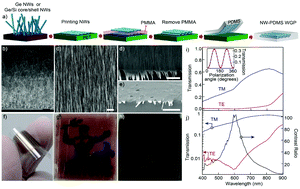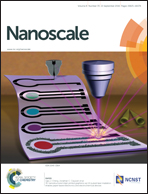Highly stretchable, printable nanowire array optical polarizers†
Abstract
Designing optical components such as polarizers on substrates with high mechanical deformability have potential to realize new device platforms in photonics, wearable electronics, and sensors. Conventional manufacturing approaches that rely highly on top-down lithography, deposition and the etching process can easily confront compatibility issues and high fabrication complexity. Therefore, an alternative integration scheme is necessary. Here, we demonstrate fabrication of highly flexible and stretchable wire grid polarizers (WGPs) by printing bottom-up grown Ge or Ge/Si core/shell nanowires (NWs) on device substrates in a highly dense and aligned fashion. The maximum contrast ratio of 104 between transverse electric (TE) and transverse magnetic (TM) fields and above 99% (maximum 99.7%) of light blocking efficiency across the visible spectrum range are achieved. Further systematic analyses are performed both in experimental and numerical models to reveal the correspondence between physical factors (coverage ratio of NW arrays and diameter) and polarization efficiency. Moreover, we demonstrate distinctive merits of our approach: (i) high flexibility in the choice of substrates such as glass, plastic, or elastomer; (ii) easy combination with additional novel functionalities, for example, air permeability, flexibility/stretchability, biocompatibility, and a skin-like low mechanical modulus; (iii) selective printing of polarizers on a designated local area.



 Please wait while we load your content...
Please wait while we load your content...